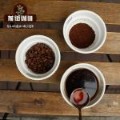Coffee will produce chemical reactions during roasting. The sour taste and source of coffee.
Coffee beans produce numerous chemical reactions during roasting, which not only change the color of coffee beans, but also create hundreds of flavor and aromatic compounds that no longer exist before. The roasting of coffee beans makes the beans crisp so as to facilitate grinding and enhance the internal permeability of coffee beans. Through the fusion with water, it is more conducive to the extraction of soluble flavor factors in coffee beans.
One: the sour taste of coffee
1. The sour taste in the coffee gives the vitality and hierarchical sense of the coffee, without the sour taste, the coffee will appear very insipid.
two。 The planting altitude of coffee determines the acid content of coffee, especially the natural ecological environment and humidity in coffee producing areas determine the type and content of acid in coffee.
3. A few other organic acids in coffee can also improve the flavor of coffee at low concentrations, which can produce an unpleasant flavor when not measured. The concentration of these organic acids is the highest at the shallow baking degree, and becomes weaker and weaker with the deepening of the baking degree.
Second: the source of sour taste
1. Chlorogenic acid (CGA) is a common acid in all raw coffee beans, accounting for 6% to 8% of the net weight of coffee. Coffee is the plant that contains the most chlorogenic acid in the world. Chlorogenic acid is an important source of coffee acidity and bitterness, and has a slight nerve stimulating effect on people. Continuous baking can degrade chlorogenic acid, leaving only 50% of chlorogenic acid in light-roasted coffee beans and about 20% in deep-baked coffee beans. Chlorogenic acid decomposes in the baking process: citric acid, malic acid, quinic acid, organic acid and so on. The acid we taste comes from the acid produced during the baking process.
two。 A little quinine and organic acid caffeic acid can make the coffee taste bright, clean and slightly sour, but once the amount is more, the taste of coffee becomes sharp and sour. As the baking degree deepens, the sour taste becomes more and more obvious, but after the high temperature, with the deepening of baking degree, the sour taste becomes more and more obvious.
3. A few other organic acids in coffee can also improve the flavor of coffee at low concentrations, which can produce an unpleasant flavor when not measured. The concentration of these organic acids is the highest at the shallow baking degree, and becomes weaker and weaker with the deepening of the baking degree.

Important Notice :
前街咖啡 FrontStreet Coffee has moved to new addredd:
FrontStreet Coffee Address: 315,Donghua East Road,GuangZhou
Tel:020 38364473
- Prev

What is the purpose of steaming? without a hill, the beans are not fresh.
What is the purpose of steaming? without a hill, the beans are not fresh. In the first step of hand-brewing coffee, a small amount of hot water is used to moisten the surface of coffee powder evenly, and the function is to drive out the gas between coffee powder with water to form a uniform void. In the later brewing process, hot water can quickly, uniformly and fully infiltrate coffee powder to achieve the purpose of uniform extraction.
- Next

The non-enzymatic browning reaction of coffee roasting what happens to the caramelization reaction?
Baking basic science-browning reaction non-enzymatic browning reaction (Nonenzymatic Browning) non-enzymatic browning reaction is different from enzymatic browning reaction, non-enzymatic browning reaction does not need enzymes, but its reaction requires heat, sugar and amino acids. There are two non-enzymatic browning reactions related to coffee roasting: caramelization (caramelization recation) and Maillard reaction (Ma).
Related
- Beginners will see the "Coffee pull flower" guide!
- What is the difference between ice blog purified milk and ordinary milk coffee?
- Why is the Philippines the largest producer of crops in Liberia?
- For coffee extraction, should the fine powder be retained?
- How does extracted espresso fill pressed powder? How much strength does it take to press the powder?
- How to make jasmine cold extract coffee? Is the jasmine + latte good?
- Will this little toy really make the coffee taste better? How does Lily Drip affect coffee extraction?
- Will the action of slapping the filter cup also affect coffee extraction?
- What's the difference between powder-to-water ratio and powder-to-liquid ratio?
- What is the Ethiopian local species? What does it have to do with Heirloom native species?

